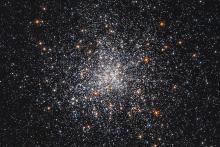Listen to today's episode of StarDate on the web the same day it airs in high-quality streaming audio without any extra ads or announcements. Choose a $8 one-month pass, or listen every day for a year for just $30.
You are here
Denebola
The tail of the lion has left its family behind it. The star escaped from the cluster where it was born. Today, it travels through the galaxy alone. Yet it hasn’t given up all traces of home. It moves through the galaxy in the same way as dozens of other stars — an indication that they may be related.
Denebola — a name that means “the tail of the lion” — is the third-brightest star of Leo. It’s in the east as night falls, at the bottom of the figure that outlines the lion. It’s almost twice as massive as the Sun, and about 15 times brighter.
Studies in recent years have suggested that it belongs to a group known as the Argus association. The stars in the group don’t all belong to a star cluster. But they all move through the galaxy in the same way. Their chemical composition is about the same, too. And they all appear to be quite young — roughly 40 million years old — just one percent the age of the Sun. In fact, several of the stars, including Denebola, are encircled by rings of dust left over from their formation — another indication of their youth.
Most members of the Argus association are in a small star cluster. But others are well outside the cluster, including Denebola. Those stars may have been born in the cluster, but later escaped. Denebola is the brightest of the bunch, mainly because it’s one of the closest to Earth — just 36 light-years away — hundreds of light-years closer than most members of Denebola’s family.
Script by Damond Benningfield






